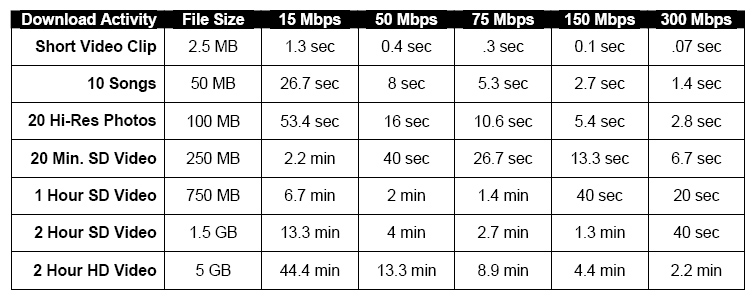Starting in June, Verizon will be doubling their current speeds offered in their FiOS internet service.
As you can probably tell, either by the headline or the image to your right, Verizon is going to be doubling their fastest speed. The current fastest is 150 Mbps, and next month that will go to 300 Mbps.
Currently, no one comes close to what Verizon is offering. Comcast offers 105 Mbps through their cable connection and AT&T offers 24 Mbps through their U-Verse fiber optics connection. Verizon’s connections are already a ways ahead of their competition, but not they are truly leaving them in the dust.
There is no word on what the prices will be. But currently you can get the 150 Mbps connection without the phone plan for $199.99 per month. I would expect all the plans, except for maybe the entry level tier, to change in price slightly to adjust for the differences in speeds. If I had to guess, I would say that the 300 Mbps would be around $250 per month. The new connections will be available on their own, or in bundled packages.
Verizon Recommendations
Verizon has given some recommendations as to what tier certain households might want to consider (download/upload):
- 15/5 would be for very basic needs, such as browsing online or checking emails.
- 50/25 is ideal for 3-4 regular users that like to download and watch videos.
- 75/35 is best for 3-4 users who want to stream HD videos or game online.
- 150/65 and 300/65 are best for households with 5 or more users.
Here is an image (which you can see on their press release linked to below) to give you a better idea of how fast these speeds will truly be:

Verizon has clearly given some thought as to how quickly consumers needs have grown over the last couple of years, as well as what those needs might be in the next few years.
“The ways we used the Internet and watched TV over the past 10 to 15 years have dramatically shifted,” said Mudge. “With the emergence of smartphones, smart TVs, Blu-ray players, tablets and gaming consoles that also serve as over-the-top devices, consumers need more bandwidth to receive the highest-quality experience.”
According to Mike Ritter, much of the need for larger bandwidth is because of the video consumption. In 2005 only about 10% of the traffic was video related. That’s expected to hit the 50% by the end of 2012, and 90% in the next few years.
The average number of connected devices will only increase too. The average number of devices in a household is 7, but is expected to increase to between 9 and 15 by 2015.
